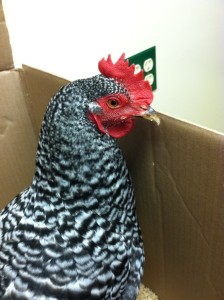Egg Peritonitis and Prolapsed Vents
Friday, August 15th, 2014It was a beautiful Spring day, and if there’s one thing that makes beautiful Spring days better, it’s having a bunch of chickens running around in the yard while you’re out enjoying the weather. So I let the chickens out, and called it a party. Things were going pretty good until I looked over and saw that Suzy Creamcheese was standing stock still over by our big prickerbush. I immediately looked up at the sky, since when the chickens freeze it often means there’s a hawk nearby. But the sky was clear, and the other chickens were running around like goobers. I went over to see what was wrong, and when I got really close, she finally ran a little bit towards the coop. Then I saw that something seemed to be stuck to her butt. I figured she was freaked out that a poop had stuck to her and didn’t know what to do. I grabbed her, and upon closer inspection, it became clear that this wasn’t a stuck poop issue, it was unmistakably a prolapsed vent.
The vent is what some people might just call the chicken’s butt. It’s where the eggs and the poop come out. A prolapsed vent is when part of the butt itself also comes out. It’s not something you hope to see, but here I was looking at it, and I knew I had to act quickly. I brought her right inside and put her in a dog crate with puppy training pads on the floor, because wood chips can get stuck to the prolapse and only make things worse. I covered the crate with a sheet so she wouldn’t move around too much, and started looking up what to do.
There are many different substances you can put on the prolapse, but whichever one you choose, the treatment always ends with you having to push the prolapse back inside. Luckily, I had a box of rubber gloves on hand, so this would only be slightly less gross than I had expected. I picked honey as my first substance to put on the prolapse. Honey is antiseptic, and we also had a lot of it, so that made it an easy choice. I rubbed the honey on, and gently tucked the beast back inside. It popped right back out. I tried this several times, and each time it popped back out, so I left it alone for a while. Later that night I tried again, but with the same results.
The next day, I moved on to Bag Balm as my substance. I donned a rubber glove, smeared some balm on the prolapse, gently tucked it back in, and it popped right back out again. I decided to leave it alone and see how things were when I got home from work. I tried the tuck again, but with the same results. I knew a lot hinged on this thing staying inside, but I just could not get it to do it. I emailed a woman I know who knows a lot about chickens, and resolved to go buy hemorrhoid cream, the last of the things people said to smear on a prolapse. There was some thinking that since it shrinks hemorrhoids, it can help shrink the tissue in a prolapse, which will help it stay inside. I had my doubts that this was true, but I was willing to try anything. I went to a store with automated check outs so no one needed to see my purchase.
I heard back from my friend, and she didn’t think things looked good if the prolapse wouldn’t stay in. She said if it was her chicken she would consider culling it. This was the first time in my chicken experiment that someone suggested killing the chicken and I thought they had a point. I resolved to try the hemorrhoid cream and take it from there.
I think you probably see where this is going. The hemorrhoid cream didn’t work any better or worse than any of it. I called the vet and told them I had a chicken with a prolapsed vent, and I thought she might need to be put down, but I wanted to talk to the vet before doing so. They got me in that night.
The vet was very helpful. He told me the various steps he could take, but without knowing if there were other factors involved, he couldn’t say how good an idea any of them were. He asked me about her health lately, and suddenly a lot of things began to come together. Suzy Creamcheese had molted twice over the winter, but based on a question I asked on the internet, it seemed like that could have been due to numerous Polar Vortices we had experienced. She had also been laying the eggs without shells, which I talked about in the “chicken finger” episode. The vet felt that these were not signs of a well chicken. I pointed out that she had totally perked up since we were there, and he pointed out that this was a defense mechanism, since he was a new person so she had to keep up appearances. And then as we talked, she rested her head on the side of the box she was in and closed her eyes. “That’s not something she should be doing,” he said. “I don’t think this chicken is well at all.” I agreed, and decided it was time to let Suzy Creamcheese go. She had been dealing with the prolapse for several days, and who knows what else. We said our goodbyes, and the vet took her away.
The next day the vet called me and let me know I had absolutely made the right decision. She had been suffering from egg peritonitis, which happens when egg yolk gets into the abdomen from the reproductive system and causes an infection of sorts. This will kill a chicken, and there is no way to really know it’s happening, and no treatment. Instead, you see things like I saw with the winter molting – unusual behaviors that might be chalked up to something else. It was a relief to know I had done the right thing, but it didn’t make me feel any better about it. Suzy had been one of my favorites and now she was gone. I wished I could have caught this sooner so she didn’t suffer, but there wasn’t any way to know this was happening. I did the best I could with the tools I had. I suppose that’s all you can do.
(CREDITS: Theme music: Chicken In The Barnyard by Fireproof Babies, Music Bed: Old Strange by The Black Twig Pickers and Steve Gunn)




